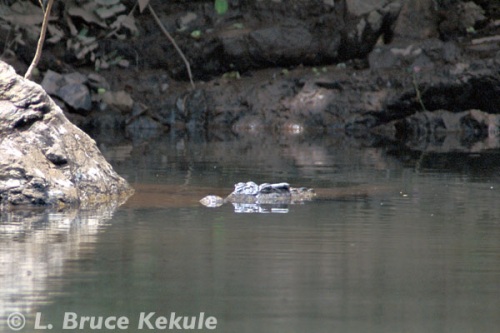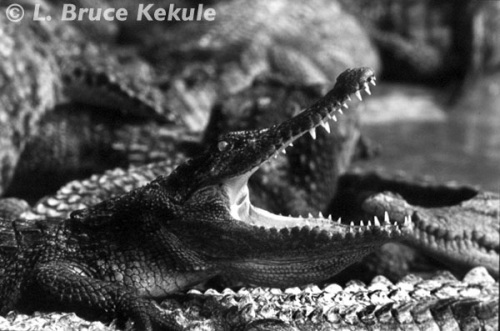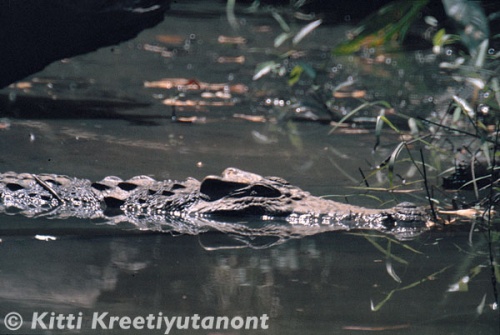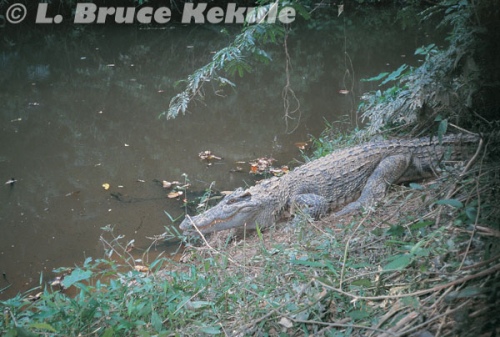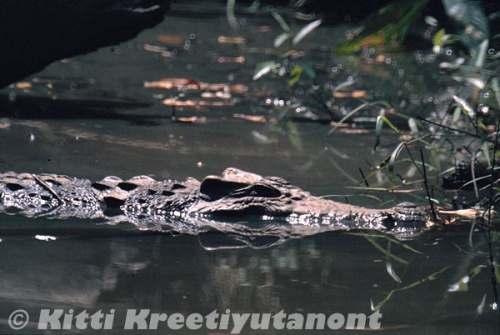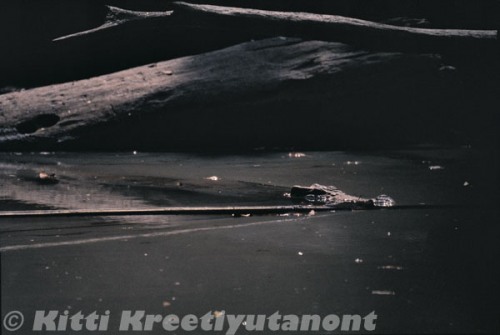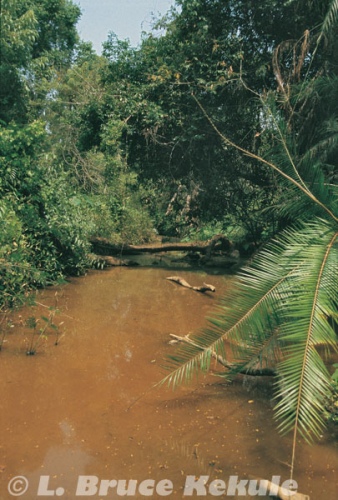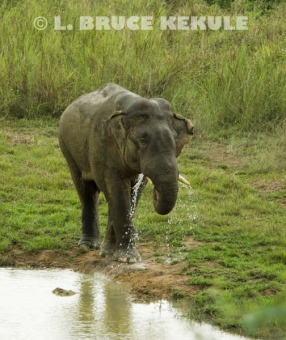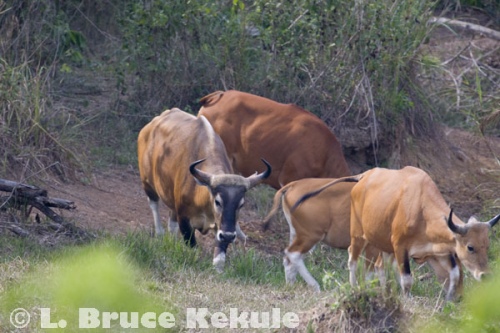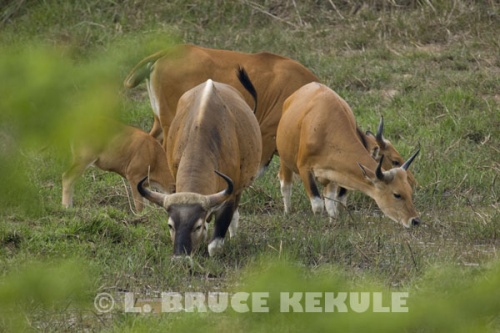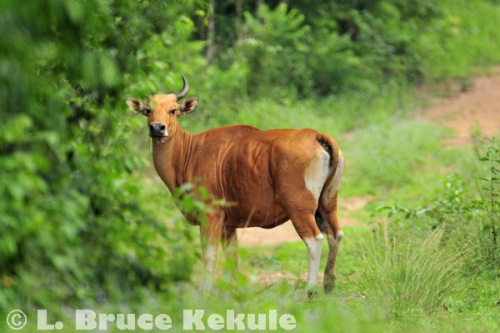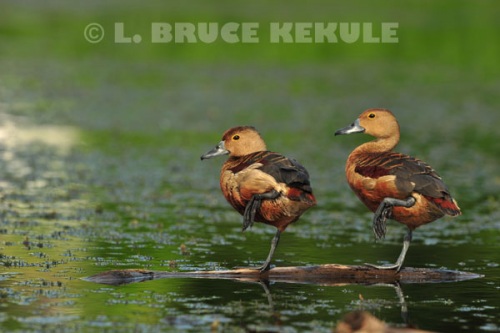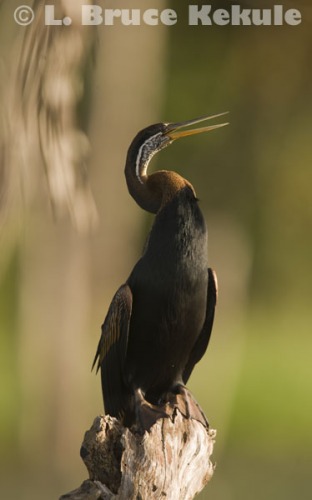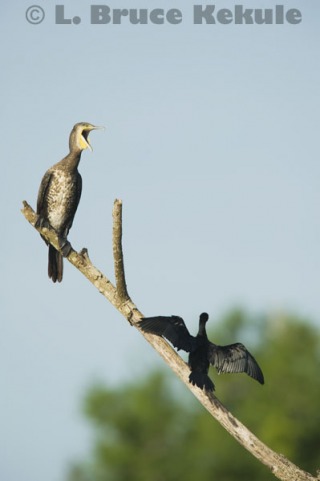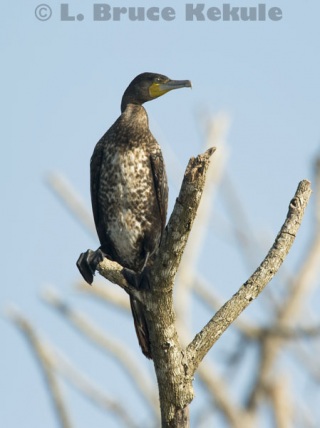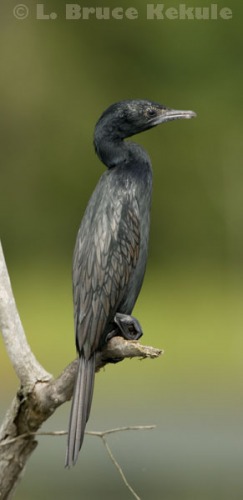Posts Tagged ‘siamese crocodile’
The Siamese Crocodile – Update 2011
Critically endangered crocodilian species
Thailand’s last few remaining wild crocodiles
Two hundred and thirty million years ago, the first crocodilians evolved from archosaurs or ‘ruling reptiles’ during the mid-Triassic period of the Mesozoic era when primitive dinosaurs also roamed the planet. Crocodiles have changed little in body structure since then. Apart from birds, these reptiles are the only living archosaurs.
My first Siamese crocodile in Khao Ang Rue Nai Wildlife Sanctuary
“Note forest fly on the eye node; these insects take saline from the croc’s eyes”
In 1909, J.B. Hatcher discovered a few fossilized bits and pieces of a giant alligator in Montana from the late Cretaceous period 80 million years ago. Deinosuchus was also found in Texas by Barnum Brown of the American Museum of Natural History in New York in the 1940s. The skull of this huge crocodilian is two meters long and body length estimated at about 12 meters with a weight of 8.5 tons.
Sarcosuchus was another crocodile some 12 meters long and weighing up to 10 tons. Fossils were first found in Central Africa from the early Cretaceous 112 million years ago by French paleontologist Albert-Felix de Lapparent in 1964, and then by France de Broin and Phillip Taquet in 1966. Later in 1997, Paul Sereno discovered more fossils in the sub-Sahara desert and then tagged the beast as ‘Super-Croc’.
This huge crocodilian was also unearthed in Brazil by a British geologist, and described by Eric Buffetaut and P. Taquet in 1977 as the same species found in Africa. These ‘super-crocs’ pulled dinosaurs and other large animals into the water and devoured them.
The same crocodile camera trapped in Khao Ang Rue Nai
In 1979, Nares Sattayarak, a geologist for the Department of Mineral Resources working in the northeast province of Nong Bua Lamphu discovered the lower jaw of a huge crocodile in a road-cut excavated from the Phu Kradung Formation of the late Jurrasic 150 million years ago. Named Sunosuchus thailandicus, it was described as a new species by Eric Buffetaut and Rucha Ingavat. Estimated to have been at least eight meters in length with a lower jaw over a meter long, it was Thailand’s ‘super-croc’.
Then in 2005 a fossil several million years old of a ‘gavial’, a large fish-eating crocodilian was unearthed by Dr Yaowalak Chaimanee and her team from the Department of Mineral Resources. This discovery was made on the Khorat Plateau at Ban Khok Sung in Nakhon Ratchasima province. The species still exists in Burma and India.
Sometime in 2006, Komsorn Lauprasert, a scientist at Mahasarakham University discovered another species of crocodilian 100 million years old that had longer legs than modern-day crocodiles and probably fed on fish, based on the characteristics of its teeth.
My second Siamese crocodile in Kaeng Krachan National park
According to Komsorn, “They were living on land and could run very fast”. The 15cm. long fossil-skull was originally retrieved from an excavation site in Nakhon Rathchasima province and then found in a museum. The species has been named Khoratosuchus jintasakuli after the province and the last name of the director of the Northeastern Research Institute of Petrified Wood and Mineral Resources, Pratueng Jintasakul.
Some 50 years ago, Thailand had three species of wild crocodiles found in a host of environments: the sea, estuaries, rivers and marshes. The most common species was the Siamese crocodile (Crocodylus siamensis) and was considered a pest by village folk who lived near waterways that had the reptiles.
Another thin-snouted freshwater crocodile was (Tomistoma schlegelii), also known as the ‘false gharial’ found only in rivers of the southern peninsula.
Crocodile river in Khao Ang Rue Nai
The estuarine ‘saltwater’ crocodile (Crocodylus porosus) today is the largest in the world also known as the ‘Indo-Pacific’ crocodile. The species was very common in river estuaries and islands in the Andaman Sea and the Gulf of Thailand. Huge saltwater crocs have been sighted swimming in open-ocean.
Unfortunately, both the saltwater and false gharial has disappeared from the wild of Thailand, and the Siamese is technically extinct with only two individuals left; one in the East and one in the West of the Kingdom. This is truly a sad state of affairs concerning the crocodile after having outlived the dinosaurs for more than 65 million years.
The Siamese crocodile was once very common in Southeast Asia including Thailand, Vietnam, Cambodia, Indonesia, Malaysia, Laos and possibly Burma. Populations throughout the region have seriously declined and exact numbers of wild crocs are not known in any of the range countries.
Wild Siamese crocodile in southern Cambodia
There is a small population still thriving in Cambodia. However, their habitats are under serious threat from hydroelectric dam construction and could be wiped out very soon.
Conservationists from ‘Flora and Fauna International’ and ‘Wildlife Alliance’ are capturing wild Siamese crocodiles and plan to use these to launch a conservation breeding-program in partnership with the Cambodian Forestry Administration. My close friend and English wildlife photographer Allan Michaud has photographed a Siamese crocodile in southern Cambodia.
Crocodilians for most of their 230-million-year history have been large, long-bodied, aquatic carnivores. Armor plating (in the form of bony scutes set in their hides), extended tails, short strong limbs, and powerful sharp-toothed jaws make them formidable predators.
Crocodile tracks by the Phetchaburi River
Crocodiles come onto land to defecate and, being cold-blooded, to bask in the sun to regulate their body temperature. Female crocs come ashore to lay 20 to 40 eggs in mound nests on land near the water’s edge. These streamlined submarine predators glide through water with ease, surfacing and submerging at will.
Siamese crocs grow broad and heavy, and mature individuals have distinct bony ridges behind the eye socket. Historical records report specimens of up to four meters in length but three meters is the average for a mature adult. They feed primarily on fish but also take frogs, small mammals and birds. Undulating their powerful tails while tucking in their legs, crocs can glide through water without making a ripple.
Stealthily stalking prey along the water’s edge, they can snatch in an instant with powerful jaws pulling it below to drown their victim. Some crocs lay in wait on the bottom of a river or pond in order to grab fish and can stay underwater for an extended period of time.
Crocodile pond in the Phetchaburi River
If the carcass is too large to swallow whole, they stash it under water until ripe and then tear it apart. Adults can survive for many months without a meal and thus are one of nature’s most efficient predators in terms of consumption proportionate to body size.
Man is the crocodile’s only enemy, and the wild Siamese crocodile is probably the most endangered crocodilian species in the world wiped out by man’s greed.
At the end of World War II, crocodile farming came into vogue in the Kingdom, and wild crocs were captured for breeding stock. Thousands upon thousands were caught in the booming trade. Habitat loss and crocodile farming started the countdown to extinction for these ancient creatures. With no laws to protect them, crocs were eradicated from every river and swamp in the country.
River carp at the crocodile pond in the Phetcahburi River
Farming crocodiles is big money business in Thailand. The false gharial and saltwater crocs are farmed along with the Siamese. A quick growing crocodile has been produced by crossbreeding the Siamese with the ‘saltwater’ species producing a ‘hybrid’ found in most of the farms throughout the country. This human ‘quick-growing’ creation is farmed for its meat and hide, and continues to be a brisk business.
The recent floods in the Central Plains have allowed hundreds of legally and illegally farmed crocodiles to escape into the environment. Many have been shot, some captured and some are still on the loose. The danger to humans is probably nil. However, farmed crocs are much more aggressive than wild ones and if one is sighted, the authorities should be notified immediately.
During my career as a wildlife photographer, I have had the great fortune to photograph two crocodiles in the wild: the first one in 2001 at Khao Ang Rue Nai Wildlife Sanctuary in the East, and in 2003, the second one in the Phetchaburi River in Kaeng Krachan National Park in the Southwest. I also camera trapped the first one in 2002 shown in the lead photograph.
Siamese crocodile in the Samut Prakan Crocodile Farm
One thing has been determined about these two creatures: The old croc in Khao Ang Rue Nai is probably a male (no egg nests have ever been found here), while the mature individual in Kaeng Krachan is more likely a female as many nests have been found up-and-down the river over the years but the eggs are never fertile. Female crocs lay eggs regardless of fertilization by a male or not. The possibility of bringing the two together to mate is absolutely zero.
Some old reports suggest that Siamese crocodiles could still exist in the northeast in several other protected areas: Pang Sida National Park (Sa Kaeo province), Phu Khieo Wildlife Sanctuary (Chaiyaphum province) and Yot Dom Wildlife Sanctuary (Ubon Ratchathani province) but with no actual records, it is doubtful if they still survive in these locations.
My good friend Kitti Kreetiyutanont of the National Parks, Wildlife and Plant Conservation Department (DNP) wrote a paper on Siamese croc sightings in 1993 and, indeed, photographed one at Khao Ang Rue Nai. It is thought to be the same animal I photographed. In 2003, poachers in Yot Dom near the border with Cambodia killed a female crocodile with eggs, and its skull and skin are on display at the park.
Siamese crocodile photographed in Khao Ang Rue Nai
The DNP and other organizations should support surveys to see if any other wild crocodiles still exist in Thailand. Restocking a few carefully selected sites with yearling purebred Siamese crocodiles seems to be the only solution.
But that raises questions about the suitability of the farmed crocs available for release. Have captive animals been excessively inbred? Even more critical, have they been crossbred with other species? Only good genetic DNA analysis can unravel this intricate problem of the species’ integrity in the farms.
In 2004, the DNP in conjunction with a local crocodile farm started a pilot project to reintroduce Siamese crocodiles at Pang Sida National Park. Seven juveniles were being kept in a holding pen for future release close to Pang Sida waterfall. However, it is reported that a few escaped and the farm abandoned the project.
Over the last few years, newspaper reports of crocodiles seen in Khao Yai and Thung Salang Luang national parks were probably released without the DNP’s knowledge, and more likely to create media frenzy by someone.
The croc in Khao Yai is aggressive as several tourists found out one day standing by the banks of the river where the croc is living. The reptile rushed up to the people probably looking for food. The chief then roped off the area by the waterway. Siamese crocodiles are very secretive and avoid people period, and are difficult to see in the wild. The department should capture this croc and remove it being alien to this place above Haew Suwat waterfall.
Serious efforts are required to save Thailand’s remaining wild crocodiles. No matter how many crocodiles are kept in farms, only an intact natural population can truly save these ancient creatures from total extinction.
Thailand should serve as a role model for wildlife conservation in Southeast Asia, and the Thai people and the government should join hands to save and protect the Siamese crocodile for present and future generations. Action needs to be undertaken now to ensure that a creature of 230-million year evolution continues to survive.
The Jaws of Extinction – Siamese Crocodile
The wild Siamese crocodile is one of the most endangered crocodilian species in the world, and extreme efforts to save this species in Thailand from total extinction need to be implemented quickly
A wild Siamese crocodile in Khao Ang Rue Nai Wildlife Sanctuary
Just its head and snout are showing; Note the large forest fly on the eye node
The murky waters of a forest pool in Khao Ang Rue Nai Wildlife Sanctuary lay still and quiet during the mid-morning heat. Occasionally, a fish catching an insect would disrupt the mirror image of the pond, where forest meets water. A dead leaf gently floating down landed on the surface, causing ripples in the pool. A pair of wreathed hornbill were croaking nearby and, high in the trees, pileated gibbon sang to their crescendo.
Situated in Chachoengsao province, Khao Ang Rue Nai consists of semi-evergreen forest and many streams. The forest is surrounded by farmlands and had been squeezed down to the last 1,030 square kilometres before being designated as a wildlife sanctuary in 1977. Still, it is the largest tract of lowland forest left in eastern Thailand.
The same crocodile as above camera trapped but several years later
Fortunately, enough forest was saved where elephant, gaur, banteng and many other species have been able to survive. More than that, it is also home to possibly the last wild crocodile in the Eastern part of the country. Now extremely rare in the wild, crocodiles used to rule freshwater habitats in this part of the world. And they have been around for longer than most living animals.
The earliest crocodile evolved during the Triassic Period, some 200 million years ago, a time when primitive dinosaurs also roamed the planet. The Triassic Period was the first period of the larger Mesozoic Era, which was known also as the Age of Reptiles. However, by the close of the Mesozoic some 65 million years ago, most primitive reptiles save the crocodile had died out.
Another Siamese crocodile in Kaeng Krachan National Park
The largest fossilised crocodile remains ever found, in what is now Texas, date back about 80 million years to the late Cretaceous Period, revealing a creature estimated to have been 15 metres long and weighing over four tonnes. Only the skull of this huge crocodilian was found and it was two metres in length.
These submarine predators exist in swamps, rivers, lakes and seas, only coming out on to land to bask in the sun. Their strongest attribute is a streamlined body which enables them to glide through water with ease, surfacing and submerging at will. Crocodile are extremely secretive, disappearing without a trace in seconds. Perfect carnivores in every way, they eat very little in relation to their body size. Being very efficient creatures, they should be around for a long time to come. But sadly, that may not be the case.
Siamese crocodile in Khao Ang Rue Nai photographed by forest ranger Khun Kitti
Thailand once had three species of wild crocodile in abundance. They could be found in rivers and marshy areas of the Central Plains, and the forested areas of the East, Northeast, West and South.
The freshwater Siamese crocodile, Crocodylus siamensis, which today is just surviving in a few protected areas, was the most common. The tomistoma or false gharial, Tomistoma schlegelii, a thin-snouted freshwater species, was found in rivers of the southern peninsula. The largest crocodile in the world, the estuarine saltwater crocodile, Crocodylus porosus, was also very common in river mouths and islands in the Gulf of Thailand and the Andaman Sea.
The same croc as above by Khun Kitti
The gharial and saltwater croc are now extinct in the wild of Thailand, but are farmed along with the Siamese. A hybrid crocodile has also been reared in captivity, by breeding the Siamese with the saltwater croc, and this animal is primarily the one used for its meat and hide.
At the end of World War Two, crocodile farming was coming into vogue and animals were captured from the wild for breeding stock. It is an indisputable fact that they have disappeared in the wild as a result of habitat loss and the creation of crocodile farming. There was no protection since the reptiles were considered pests by many people living close to wild crocodile habitat.
Fresh Siamese crocodile tracks by the Phetchaburi River in Kaeng Krachan
The last remnants are now confirmed in Khao Ang Rue Nai wildlife sanctuary and Kaeng Krachan national park. In April of this year, a fresh set of crocodile tracks was discovered (by the writer) along the river near Phanoen Thung Mountain in Kaeng Krachan. Ten kilometres downriver, another set of tracks had been found previously by camera trap specialists working with the Royal Forest Department, and a photograph was taken of a single crocodile on a sandbank by using an infrared camera trap in daylight. It is presumed that a viable population exists in Kaeng Krachan but more research is needed on how many crocodile are actually there.
There are reports that Siamese crocodile may still exist in Pang Sida national park in Sa Kaeo province, Yot Dom national park in Ubon Ratchathani province, and Phu Khieo wildlife sanctuary in Chaiyaphum province, but most are old reports from 1993. Other than Kaeng Krachan, the only place with photographic evidence of the crocodile’s presence is Khao Ang Rue Nai.
Khlong Takrow in Khao Ang Rue Nai; home to one male croc
Feeding mainly on fish, the freshwater crocodile will also take frogs, birds and small mammals when opportunity arises. With their powerful tail while tucking in their legs, they can glide through water without making a ripple. Using stealth, they move up very close to prey along the waters edge and then, in an instant, grab their victim in powerful jaws before pulling it below and drowning it.
If the carcass is too large to swallow whole, they stash it under water until ripe and then tear it apart. However, adult crocodile can survive for a year or more without a meal.
Perhaps that’s one thing that has enabled the crocodile of Khao Ang Rue Nai to keep quiet and survive. But unless proper protection is provided, it may not be lucky for long.
A serious study by the Forestry Department and other organisations should be undertaken to determine the creatures sex, age and the possibility that other crocodiles exist there. If only one animal is confirmed, then something should be done to ensure the survival of the species.
Restocking with yearling purebred Siamese crocodile seems to be the only solution. But is the species in Thailand’s crocodile farms purebred? It would seem that the animals are prone to crossbreeding and inbreeding, hence the integrity might be suspect.
The Siamese crocodile in the wild is the most endangered crocodilian species in the world. It is estimated that throughout the countries where they are to be found there are now no more than 200 surviving in their natural habitat. Extreme efforts to save the crocodile in Thailand from total extinction need to be implemented. Even though there are many crocodile farms with thousands of animals in them, the true wild population is the one that counts.
Let us hope that full measures will be taken to ensure that the Siamese crocodile will continue to outlive the dinosaur and not end up like the prehistoric creatures alongside whom they once evolved.
Thailand, with all its natural resources, should be the role model for wildlife conservation in Southeast Asia. All those concerned need to work together to protect, save and regenerate the wildlife and forests so that generations to come can be proud of the Kingdom’s natural heritage.
Khao Ang Rue Nai – Natural splendor in the East
Thailand’s largest remaining tract of lowland evergreen rainforest and a very important wildlife sanctuary
During mid-morning at a secluded murky stream deep in the Eastern evergreen rainforest, a single reptile glides effortlessly through the water to a favorite basking spot. Lying on the bank some three meters long, this freshwater Siamese crocodile warms-up in the bright sunlight. Judging from the many photographs taken of this individual, it is a mature animal. Sex and actual age are not known, but it has been here for sometime now. The habitat consists of several connecting deep ponds with abundant fish stocks. The crocodile takes occasionally small mammals and birds. It is a lucky but lonely survivor.
Sunrize in Khao Ang Rue Nai Wildlife Sanctuary
During mid-morning at a secluded murky stream deep in the Eastern evergreen rainforest, a single reptile glides effortlessly through the water to a favorite basking spot. Lying on the bank some three meters long, this freshwater Siamese crocodile warms-up in the bright sunlight. Judging from the many photographs taken of this individual, it is a mature animal. Sex and actual age are not known, but it has been here for sometime now. The habitat consists of several connecting deep ponds with abundant fish stocks. The crocodile takes occasionally small mammals and birds. It is a lucky but lonely survivor.
Little grebe in the reservoir
Khao Ang Rue Nai Wildlife Sanctuary is home to probably the last truly wild Siamese crocodile in eastern Thailand. There are just a few surviving in nearby Cambodia but their future is threatened by the construction of hydroelectric dams. Since Siamese crocs can live for 60-70 years, it is hoped this individual will be in Khao Ang Rue Nai for some time to come.
Bull elephant at a waterhole
Kitti Kreetiyutanont, a forest official working in the sanctuary, recorded the first sighting of this individual in 1987 by photograph. The croc still survives to this day, and is a tribute to the tenacity and longevity of the species. However, it is a case in point where humans are to blame for the disappearance of these remarkable creatures, from the lowlands all the way up into the forest; by encroachment, poaching and logging that went on for decades.
Bull elephant on the move
Some 230 million years ago judging from fossil evidence, the first crocodilians evolved from the Archosaur. Crocodiles have outlived the dinosaur but here in Thailand, the demise of the wild species is close at hand. In the past, crocodiles were found in just about every main river system throughout the Kingdom. Modernization has brought these mystical creatures to the brink of extinction. They were mainly captured to stock crocodile farms, and were also killed by the people who mostly feared the sometimes aggressive reptiles. With no laws in place at the time to protect these animals, extinction was imminent.
Banteng herd at a waterhole in Khao Ang Rue Nai
However, a very small reintroduction program could be implemented here, and with increased protection, could work to save the remarkable Siamese crocodile from extinction in the wild. There are several other sites that can also be used for reintroduction such as Yot Dom National Park in Ubol Ratchathani province, and Phu Khieo Wildlife Sanctuary in Chaiyaphum province where crocs were once common. There are thousands upon thousands of crocodiles in farms, mostly by crossbreeding and hybridization. A wild population is the only option. A few of the crocodile farms still have
Banteng herd at a waterhole
Siamese crocodiles taken from the wild and could easily start a program to save the species. There has been one attempt at a national park to release crocodiles but it apparently was abandoned. Also, several Siamese crocodile have mysteriously showed up at Khao Yai and Thung Salang Luang national parks and believed to have been released clandestinely. These crocodiles should be captured and DNA checked to see if they are truly wild crocs.
Banteng cow with a lame right rear hoof
Khao Ang Rue Nai is situated in the provinces of Chanthaburi, Prachin Buri, Chachoengsao, Chon Buri and Rayong. The sanctuary headquarters is located about three hours drive from Bangkok and was established in 1977 by Royal Decree. The protected area consists mainly (80 percent) of dry-evergreen forest with moist and hill evergreen, dry dipterocarp and mixed-deciduous forests interspersed with many streams, and are eastern Thailand’s largest remaining tract of lowland evergreen rainforest in the country. An annual rainfall of some 3,000 to 4,000 millimeters (118-160 inches) has been recorded.
Mother elephant and infant
The sanctuary is 1030 sq. km (398 sq.miles) in area and is part of the Prachinburi floodplain. It is the largest protected area of the Eastern Forest Complex, which includes four national parks and three wildlife sanctuaries: included are Khao Chamao – Khao Wong, Khao Khitchakut, Namtok Phlio and Khlong Kaeo national parks, and Khao Soi Dao, Khlong Khrua Wai Chaloem Phrakiat and Khao Ang Rue Nai wildlife sanctuaries. Unfortunately, these protected areas are mere islands in a sea of humanity.
Burmese reticulated python
In the old days, the Eastern Forest Complex was known as the Phanom Sarakham forest, and was one of the richest forests in Thailand famed for its abundant flora and fauna covering an area of about 8,000 square kilometers. Just a short 50 years ago, this dense, lush and vast jungle was home to large herds of elephant, gaur and banteng. Tigers and Asian wild dogs were common as were most of the smaller mammals like sambar, serow, wild pig, and muntjac (barking deer). Hornbills and gibbons, indicator species of an intact forest, thrived. But that quickly shrank as the human population expanded in causing irreversible damage to the ecosystems.
Variable squirrel
Due to its close proximity to Bangkok and other cities, many city hunters entered this forest at night spotlighting, either on foot or by jeep. This decimated the wildlife as everything was taken without regard for species, sex or age. The most damaging was the eight 30-year logging concessions carried out by logging companies that cut many roads into the forest. This alone-allowed easy access to virgin forest and it was not long before most everything vanished. In the meantime, this wilderness was also completely surrounded by agricultural land, which also took its toll.
Crab-eating macaque eating ‘mama’ dried noodles found in a trash can
Fortunately, and before it was too late; enough forest was saved so that the mammals and others were able to survive to the present. Although populations of the large herbivores have declined, they can be still be seen at various sites within the sanctuary. Unfortunately, the tiger has disappeared but a few Asian wild dogs still roam the interior and are at the top of the food chain.
Lessor whistling ducks
In 1967 when the Vietnam War was in full swing, the government cut many new roads through the forests in eastern Thailand supposedly to facilitate movement of US personnel and equipment from Utapao Airbase to other airfields in the Northeast. At the end of the Cambodian civil war in 1986, the Thai Army made one such road through the top half of Khao Ang Rue Nai. The impact of the road on this forest and the animals has been devastating and many creatures have been killed or maimed by vehicles on this thoroughfare.
Lessor whistling ducks
The research unit stationed at Khao Ang Rue Nai on road-kill, deer and bovid population, elephant management and jungle fowl has carried out much research. Most accidents happened from 6pm to 6am. After much publicity, the road is now closed from 9pm to 5pm everyday and road-kill has dropped 70-80 percent. This is a plus for conservation where like-minded people have taken action to help prevent further carnage of wild animals.
Lessor whistling ducks
A total of 132 mammal, 395 bird, 32 amphibian and 107 reptile species have been recorded. Thousands of plant and insect species are found. Birds such as the black-and-red broadbill and the Siamese Fireback thrive. The rare woolly-necked stork and lesser adjutant once lived in these forests but have not been seen for sometime and are presumed extinct locally.
Oriental darter
Rare water birds like the Oriental dater and great cormorant migrate here and stay for several months at a reservoir built near the headquarters. This water source was created for the elephants during the dry season hoping to help eliminate human-elephant conflict. The marauding giants in search of food and water have killed and hurt many people. There are also recent reports of foraging gaur attacking farmers outside the sanctuary by mostly young bulls kicked out of the herd.
Oriental darter
The dangers facing Khao Ang Rue Nai are now severe as poachers and farmers snare indiscriminately. Cheap and simple rope snares have killed many elephants, gaur and banteng plus many other mammals. The villagers say they are protecting their crops. But many areas are in close proximity to the forest and interaction between wild beast and humans is a serious problem for the National Parks, Wildlife and Plant Conservation Department, who are constantly under pressure from these conflicts. More personnel and protective management plus a bigger budget are needed to protect these forests.
Great cormorant and little cormorant
Great cormorant
Little cormorant
But it must also be understood by the general public that wildlife sanctuaries are not open to the general public and have been set aside for species conservation, protection and bio-diversity research. Unlike national parks, recreation is not encouraged although it does occur, especially at waterfalls and viewpoints. Needless to say, the future of all conservation areas in the Kingdom is in the balance, and only increased protection, conservation awareness and education are the keys to sustain Thailand’s wonderful natural heritage.
Notes from the field:
For capturing images of such elusive creatures like crocodiles and elephants, infrared camera-traps are a very productive alternative to endless days of sitting in a hot photo-blind. Crocodiles are creatures of habit, so I set a camera-trap at its favorite basking spot by Klong Takrow. The croc was caught on film many times during a two-week session. One frame shown above was taken in early morning light. It seems as if the crocodile is smiling, and saying, “I’m right here”. I was elated to get such a lucky shot.
Siamese crocodile camera-trapped at Klong Takrow
Khao Ang Rue Nai is currently home to about 130 wild elephants. The road transects the northern part straight through old elephant habitat. The narrow road was widened and resurfaced allowing faster speed. In 2002, a man and woman in a pickup truck barreling through the sanctuary at high speed did not see the elephants on the road until it was too late. The truck crashed head-on into a 5-year-old tusker. The truck’s driver was killed on impact but the woman survived. The young elephant died shortly after.
The ironic circumstances of this accident – ancient animal and modern machine – weighed heavy in my heart. I had set camera-traps near the crocodile pond in the sanctuary a couple of weeks before. When the film was retrieved and processed, I was elated that a herd of elephants had triggered one of the cameras producing several frames. One frame showed an inquisitive little tusker looking straight at the camera. My elation quickly subsided a few days after the terrible news on TV and newspaper reports that a small tusker had been killed in the sanctuary. My worst fears were confirmed after consultation with Royal Forest Department officials and comparing photographs. A scar on the dead calf’s forehead proved it to be the same animal that I had ‘camera-trapped’.
Such accidents are a terrible blow to the conservation of Thai elephants, because tuskers are particularly vulnerable, being subject to hunting for their ivory. This young tusker was not the first and probably not the last elephant killed by reckless driving on this road. However, the Royal Thai Army and the Department of National Parks should be commended for taking the initiative by partially closing the road at night.
It is hoped that one day the time will be extended from 6pm to 6am to increase the animal’s chances for survival. This is the logical step and humans using this road would have to adjust to the new times for the sake of saving the wildlife.




